1 . Imbalances
Characteristics of imbalance fault symptoms:
- Main vibration frequency equal to rotor speed
- Radial vibration is predominant
- The vibration phase is stable
- Vibration changes as the square of speed
- The direction of vibration phase change is proportional to the measuring direction
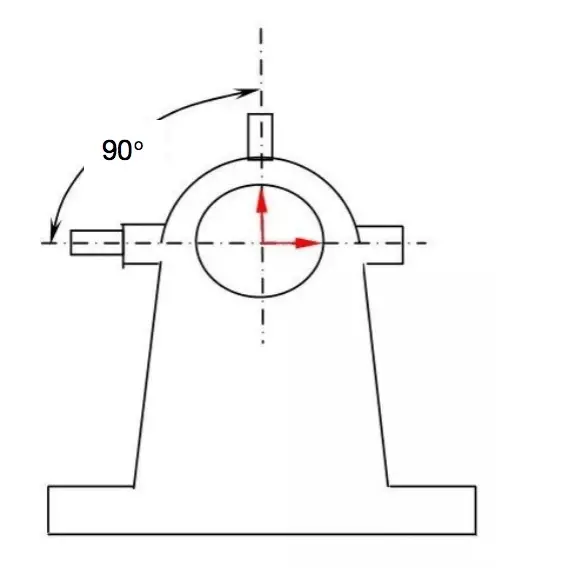
1 ) C couple imbalance
Characteristics of couple imbalance symptoms:
- It has a phase difference of 180° on the same axis;
- The 1x RPM frequency exists and dominates;
- The amplitude of the vibration changes with the square of the increase in speed;
- Can cause large amplitudes of axial and radial vibration;
- The dynamic balance needs to be corrected on two correction surfaces.
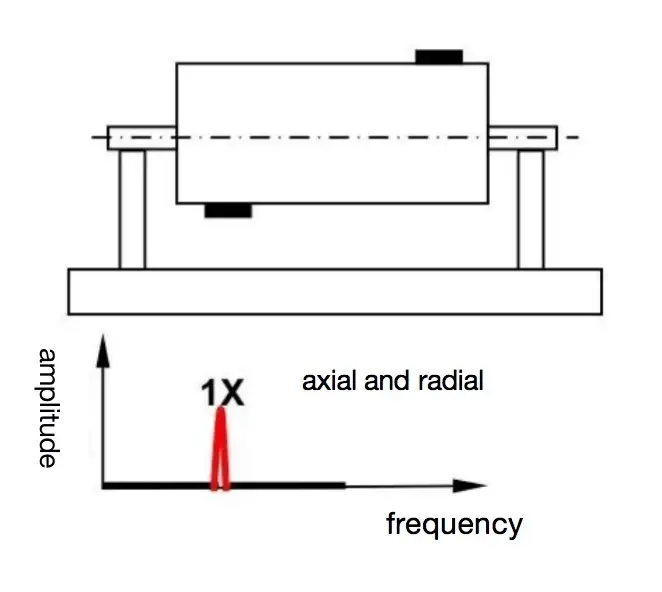
2 ) Cantilever rotor imbalance
Characteristics of cantilever rotor imbalance symptoms:
- The 1X speed frequency exists in both the radial and axial directions;
- Readings in the axial direction are in phase, but readings in the radial direction may be unstable;
- Cantilever rotors often have force and force-torque imbalances, so both need to be corrected.
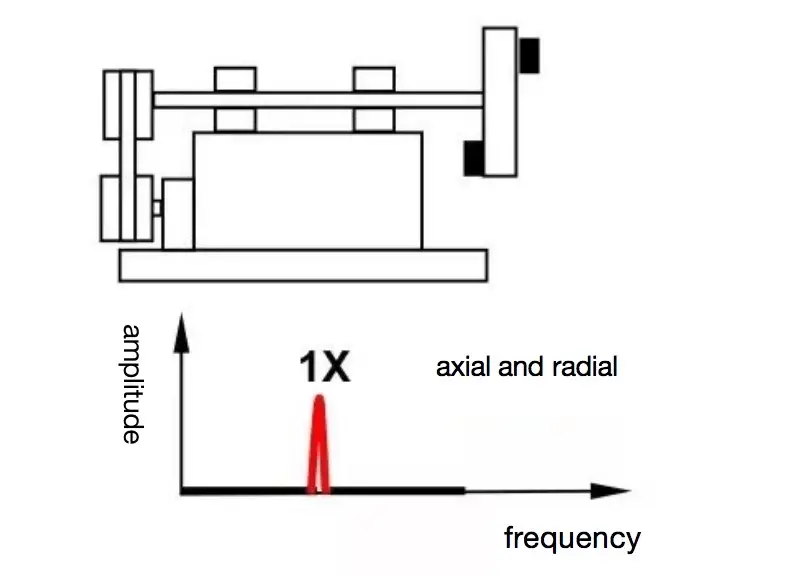
two . Misalignment
1) AN angular misalignment
Characteristics of Angular Misalignment Symptoms:
- The characteristic is high axial vibration;
- It has a 180° phase difference between the coupling sides;
- Typically has high axial vibration at 1X and 2X speeds;
- Typically, 1X, 2X, or 3X RPM frequencies do not dominate;
- Symptoms may indicate coupling failure.
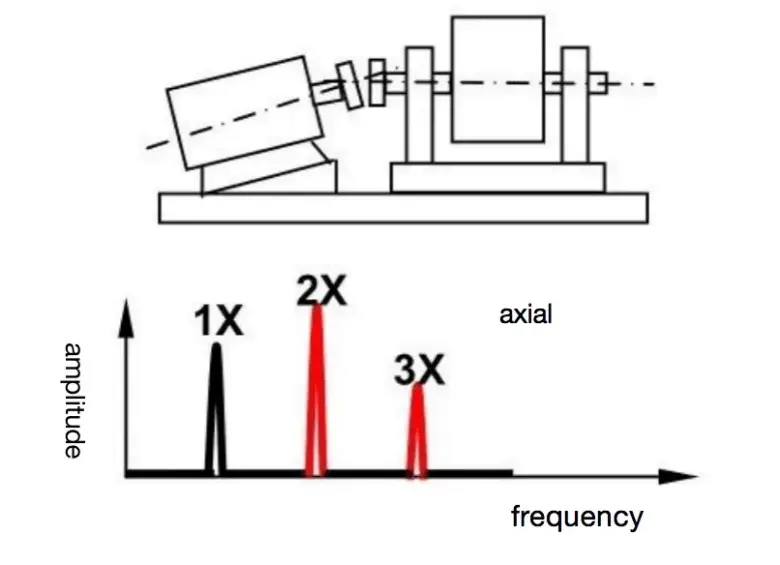
2) Parallel misalignment
Characteristics of parallel misalignment symptoms:
- When vibration with a phase difference of 180° in the radial direction is severely misaligned, higher harmonic frequencies are generated;
- The 2X RPM amplitude is often greater than the 1X RPM amplitude, which is similar to the symptoms of angular misalignment;
- Coupling design can affect the shape and amplitude of the vibration spectrum.
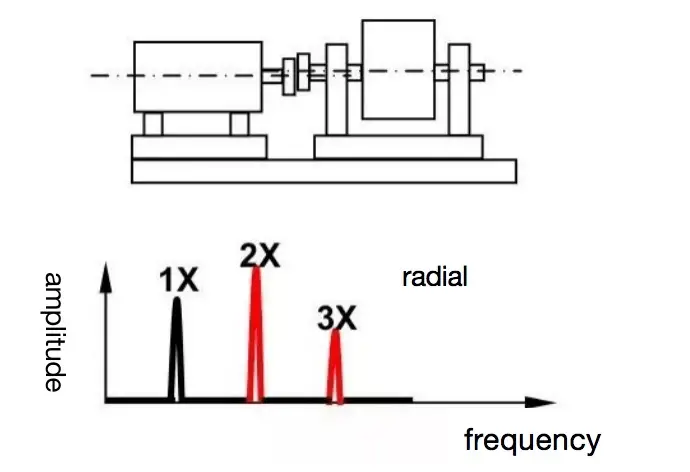
3). Inclined bearings
Characteristics of tilted bearing symptoms:
- Vibration symptoms are similar to angular misalignment;
- Trying to re-center the coupling or balance the rotor does not solve the problem;
- Produces a phase change of approximately 180° laterally;
- There is a twisting movement to the side or from top to bottom.
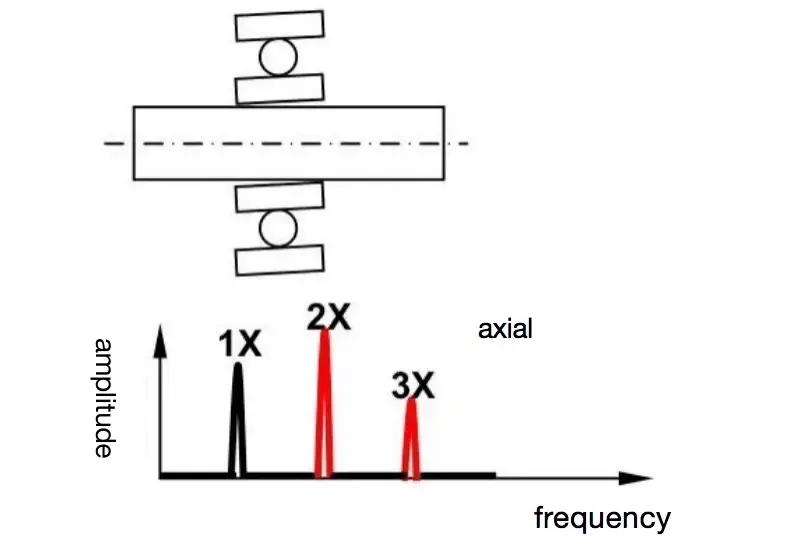
3 . Eccentric rotor
Features of eccentric rotor symptoms:
- It has 1x maximum speed frequency vibration in the direction of the rotor centerline;
- The relative phase difference is 0° or 180°;
- Attempting dynamic balancing will decrease the vibration amplitude in one direction but may increase vibration in the other direction.
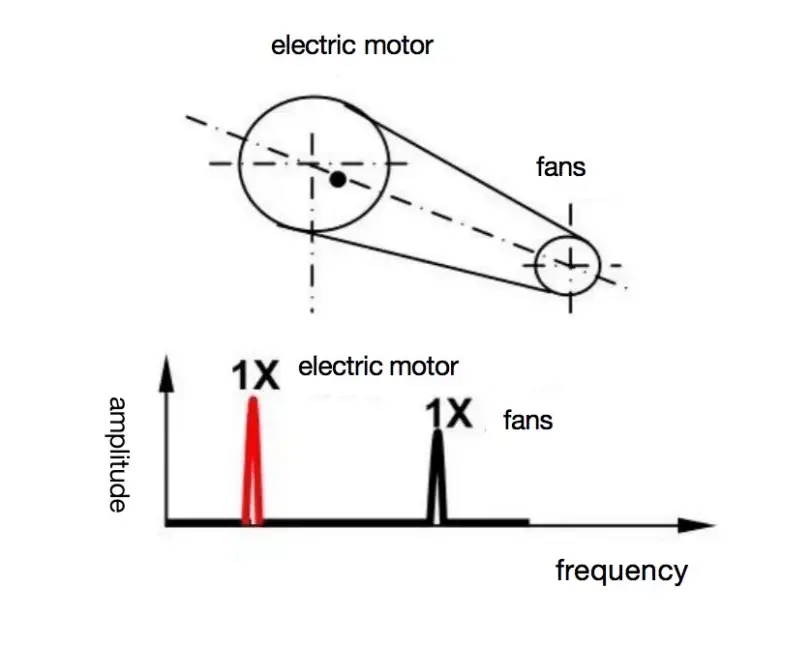
4 . bending axis
Features of flexion axis symptoms:
- Large axial vibration is produced from a bent shaft;
- If the curve is close to the center of the shaft span, the 1X speed frequency predominates;
- If the curve is close to both ends of the shaft span, the 2X speed frequency predominates;
- The phase difference in the axial direction tends to be 180°.
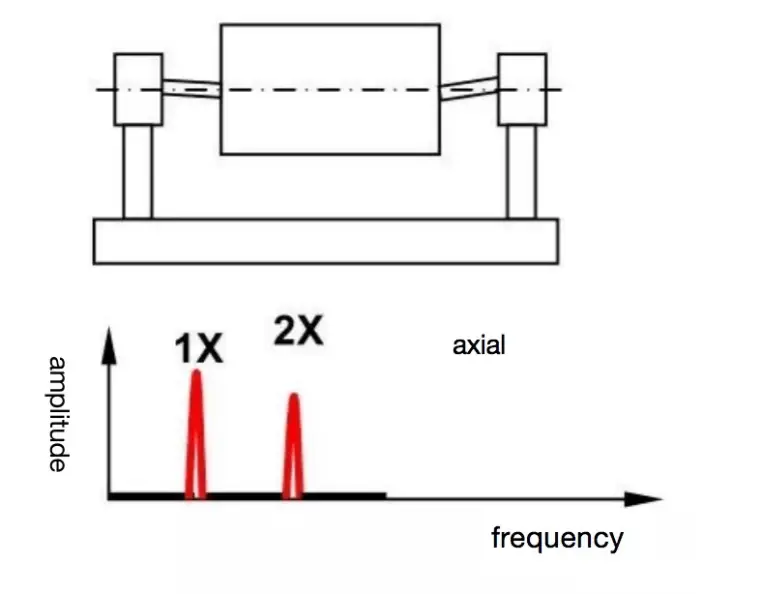
5 . Mechanical loosening
1)M mechanical loosening (A)
Characteristics of mechanical loosening symptoms (A):
- It is caused by the loose structure of the machine feet;
- Deformation of the foundation will cause “soft base” problems;
- Phase analysis will reveal a vertical phase difference of approximately 180° between the machine base plate components.
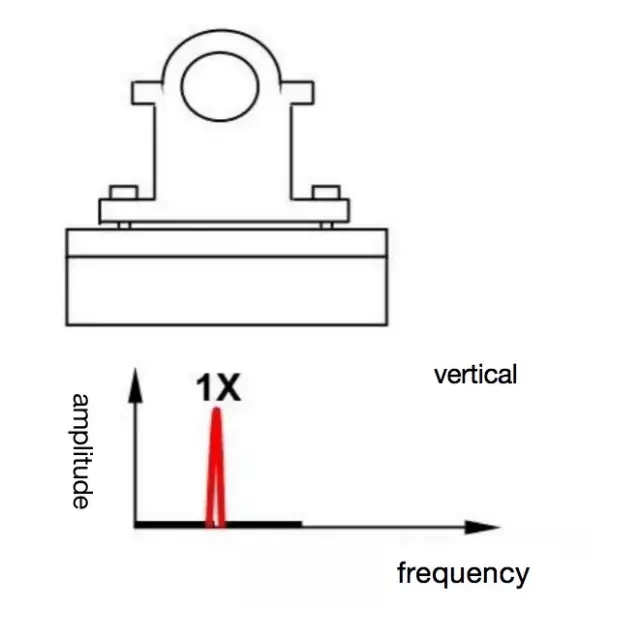
2 ) Mechanical loosening (B)
Characteristics of mechanical loosening symptoms (B):
- It is caused by loose anchor bolts;
- Cracked structures or cases can produce vibration at speed frequencies of 0.5X, 1X, 2X, and 3X.
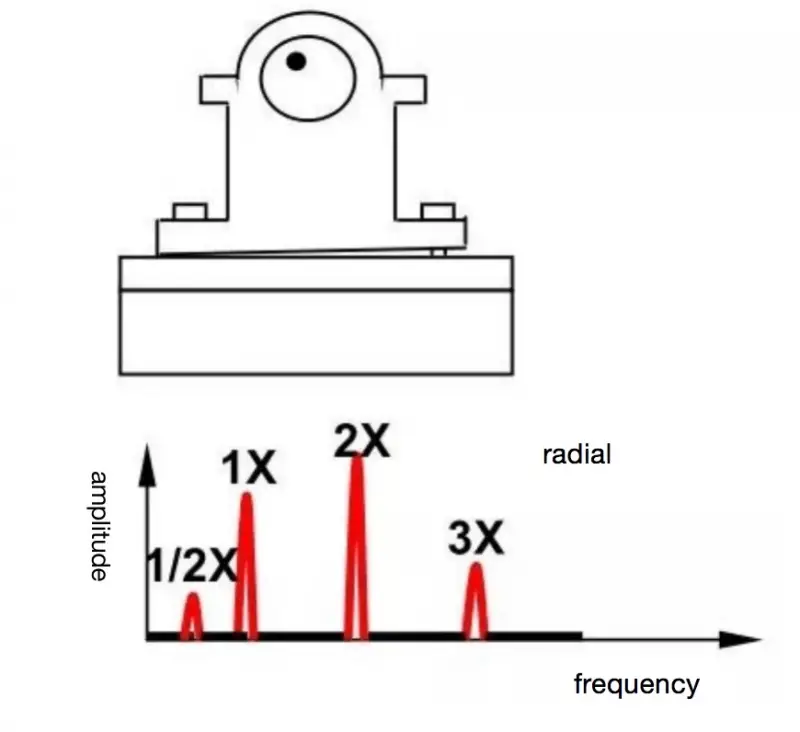
3 ) Mechanical loosening (C)
Characteristics of mechanical loosening symptoms (C):
- The phase is usually unstable;
- Many harmonic frequencies will be generated.
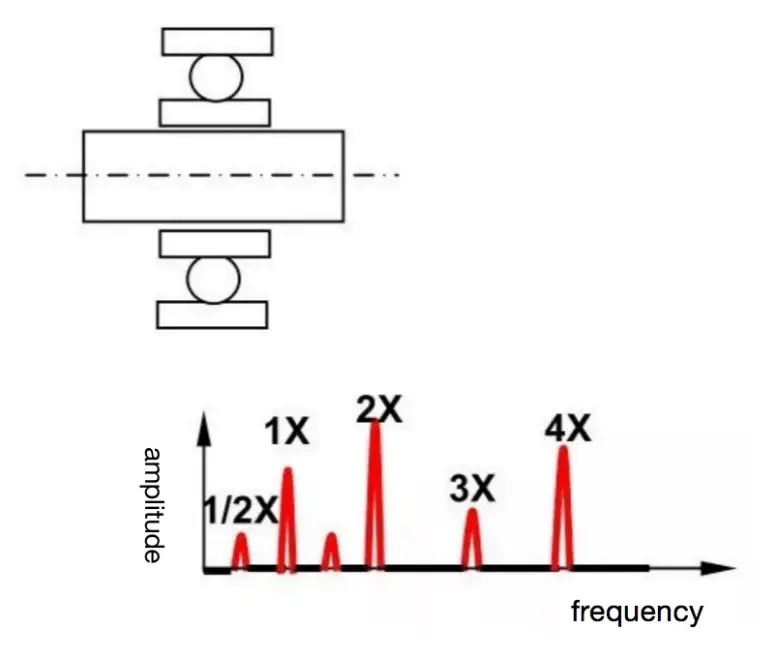
6 . Rotor friction
Characteristics of rotor friction symptoms:
- The vibration spectrum is similar to mechanical loosening;
- It normally produces a series of frequencies that can excite self-excited vibrations;
- Subharmonic frequency vibration of speed may occur;
- Friction can be partial or full circumference.
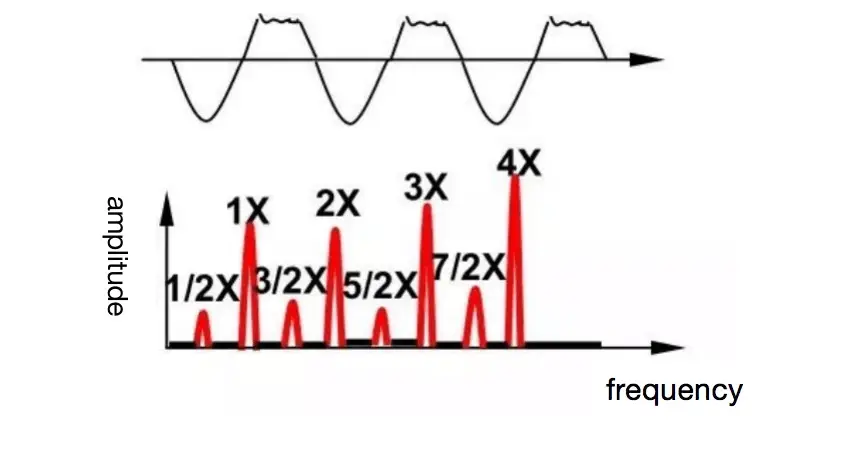
7 . Resonance
Characteristics of resonance symptoms:
- Resonance occurs when the frequency of forced vibration coincides with the frequency of self-oscillation;
- When the shaft passes through resonance, the phase changes by 180°, and when the system is in resonance, a large amount of vibration will be generated.
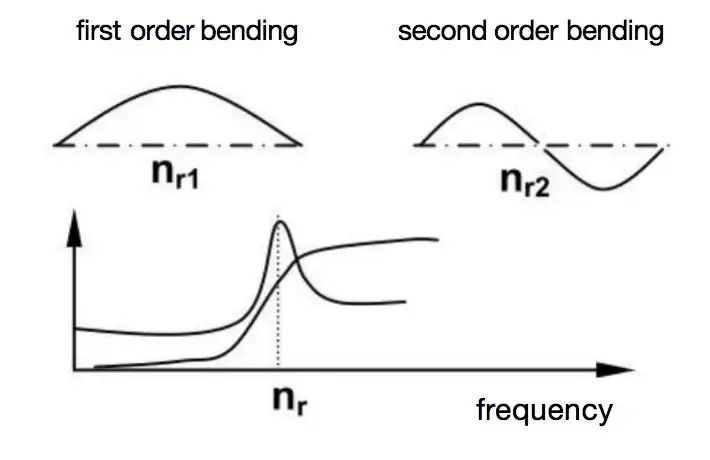
8. Belt and pulley
1 ) Belt resonance
Features of belt resonance symptoms:
- If the self-oscillation frequency of the belt coincides with the frequency of the drive speed or the driven speed, large vibrations may occur;
- Changing the belt tension can change the self-oscillation frequency of the belt.
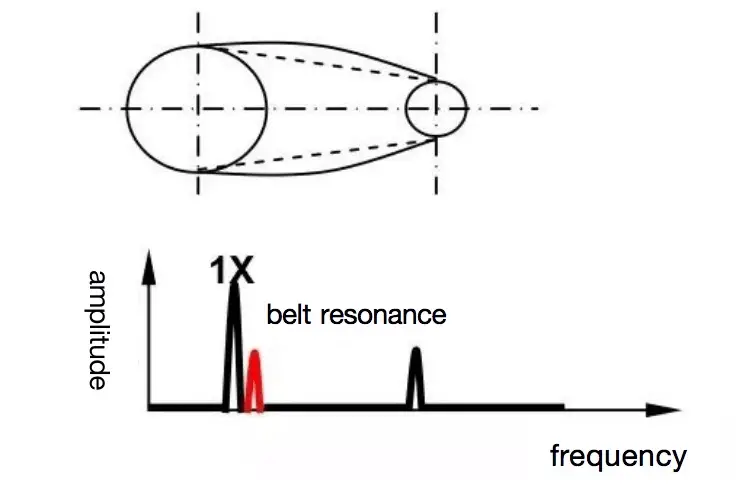
2 ) Worn, loose or incompatible belts
Features of Worn, Loose or Incompatible Belt Symptoms:
- 2X RPM frequency dominates;
- The amplitude of the vibration is often unstable, sometimes in pulses, frequencies or driven speed frequencies;
- Worn or misaligned gear belts will produce large amounts of vibration at the gear belt frequency;
- The belt vibrates at a frequency lower than the drive speed or driven speed.
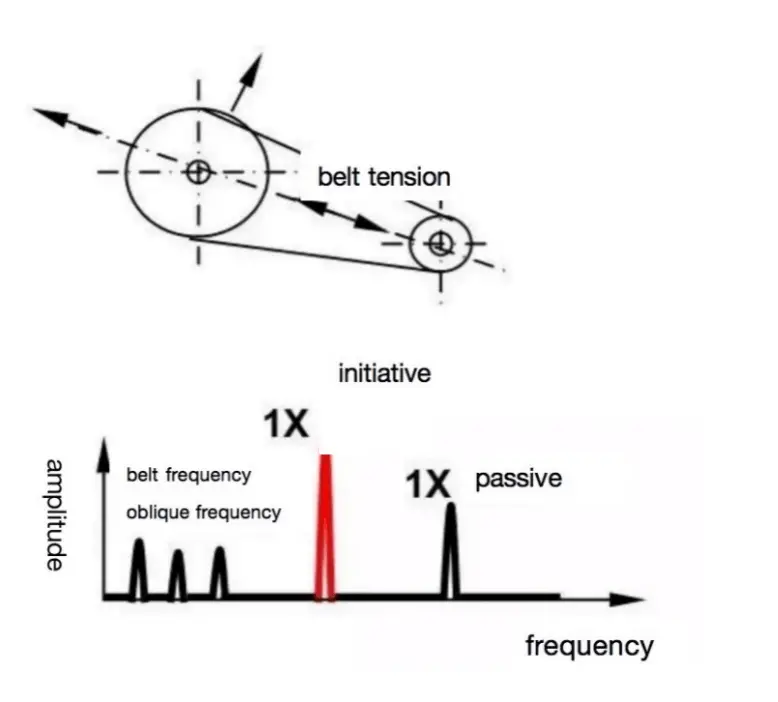
3 ) Eccentric pulleys
Features of eccentric pulley symptoms:
- Eccentric or unbalanced pulleys will produce large values of pulley vibration at 1x speed frequency;
- It has maximum amplitude of vibration in the same direction as the belt;
- Be careful when trying to balance eccentric pulleys.
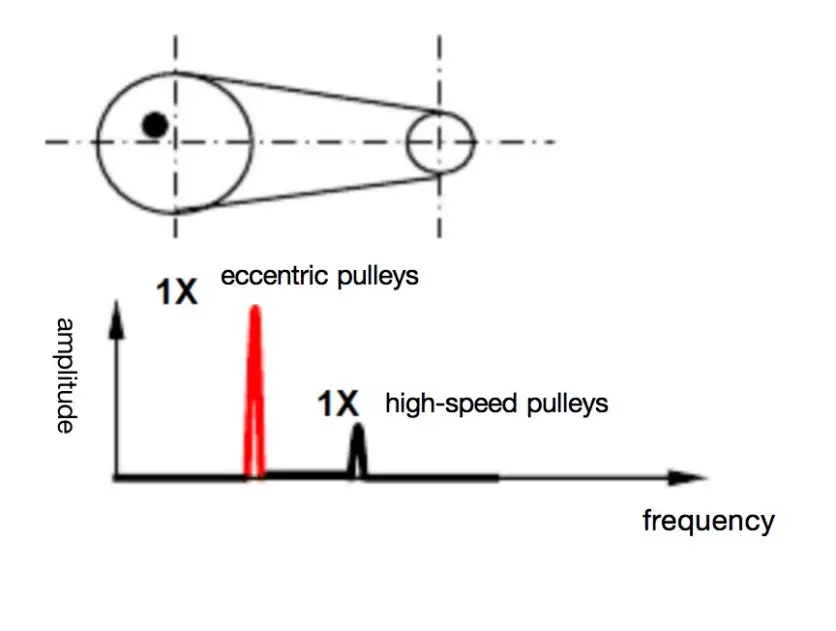
4 ) Belt/pulley misalignment
Characteristics of belt/pulley misalignment symptoms:
- A large axial vibration of 1X speed frequency will occur when the pulley is not aligned;
- The greatest amplitude of vibration in the engine is often the turbine speed frequency.
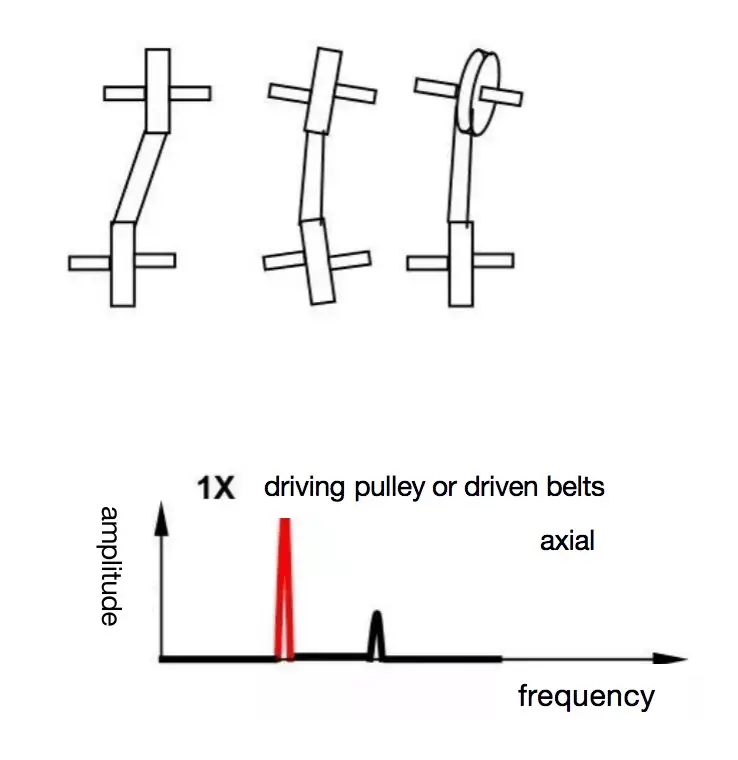
9 . Hydrodynamic excitation
1 ) Blade passing frequency
Features of symptoms of hydrodynamic excitement:
- If the gap between the blade and housing is not uniform, the blade vibration amplitude through frequency (BPF) may be too high;
- High amplitude vane passing frequency (BPF) vibration may occur if the friction ring is stuck on the shaft;
- The eccentric rotor may produce excessive blade passing frequency (BPF) vibration amplitude.
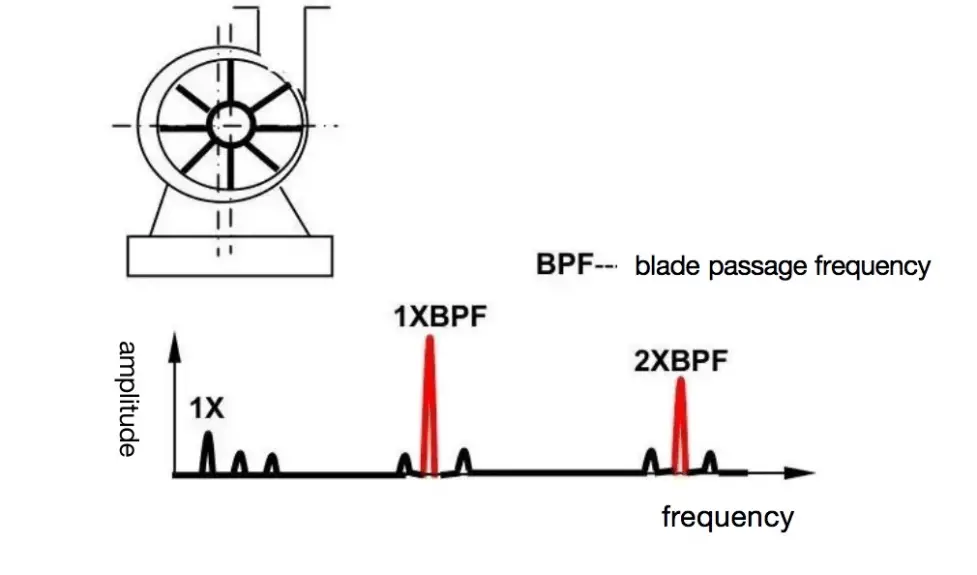
2 ) Fluid turbulence
Characteristics of fluid turbulence symptoms:
- In the fan, due to the pressure change or speed change of the air flow in the flow channel, the air flow often appears as a turbulent flow;
- It will produce random low-frequency vibrations in the frequency range of 0 to 30 Hz.
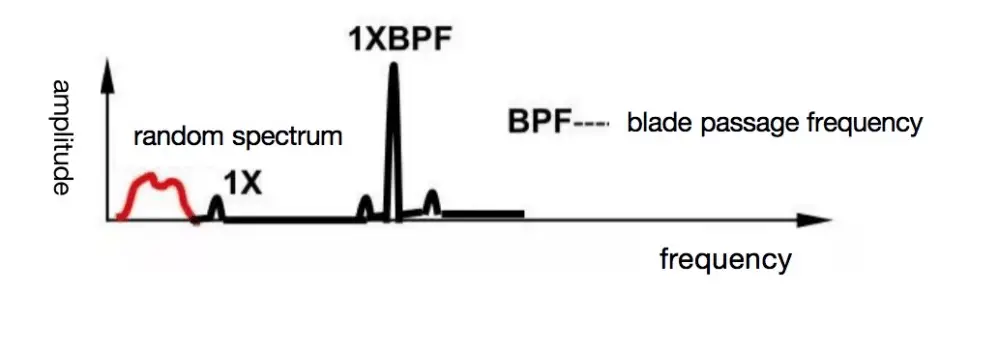
3 ) Cavitation
Characteristics of cavitation symptoms:
- Cavitation will generate high-frequency broadband random energetic vibrations superimposed on the blade passing frequency (BPF);
- Generally indicates inadequate inlet pressure;
- If the cavitation phenomenon exists, it may cause impeller blade corrosion and pump casing corrosion;
- It sounded like gravel passing through a pump.

10 . Beat vibration
Features of knock vibration symptoms:
- Beat vibration is the result of the synthesis of two vibrations of very close frequency in phase and out of phase;
- The broadband spectrum will appear as a peak above and below, and the fluctuation itself is the beat of the frequency difference between two peaks in the broadband spectrum.
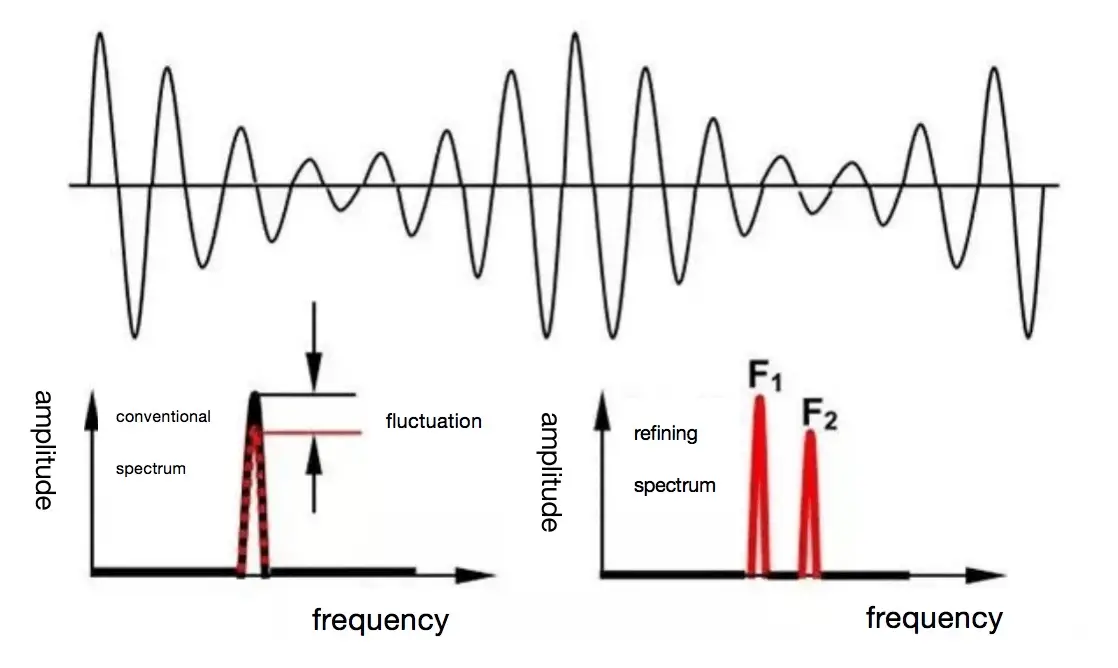
11 . Eccentric rotor
- FL power frequency (50 Hz in China = 3,000 rpm)
- Polar P
- Rotor bar passing frequency Fb = number of rotor bars * rotor speed
- Synchronous speed NS=2XFL/P
- Slip frequency FS = synchronous speed – rotor speed
1 ) Stator runout, insulation short circuit and loose cores
Characteristics of stator eccentricity symptoms, short circuits and loose cores:
- The stator problem generates high amplitude power frequencies and doubles (2FL) electromagnetic vibrations;
- The eccentricity of the stator produces an irregular air gap and its unidirectional vibration is evident;
- Feet with soft soles may cause stator eccentricity.
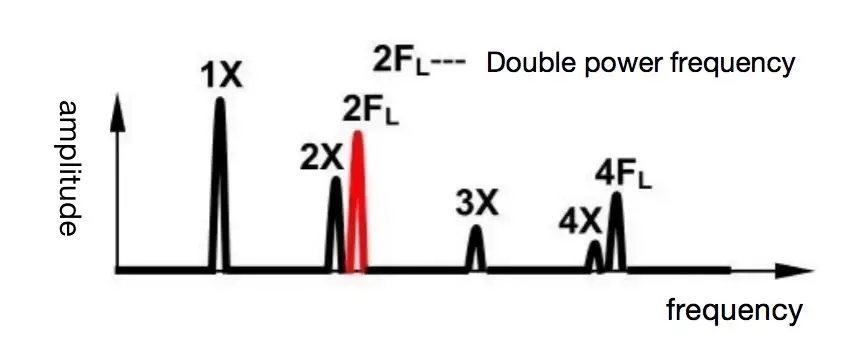
2 ) Synchronous motors
Characteristics of synchronous motor symptoms:
- It is produced by loose stator coils in synchronous motors;
- High amplitude coils vibrate and can pass frequency;
- The coils pass through a sideband on either side of the frequency that will be accompanied by a 1X speed frequency.
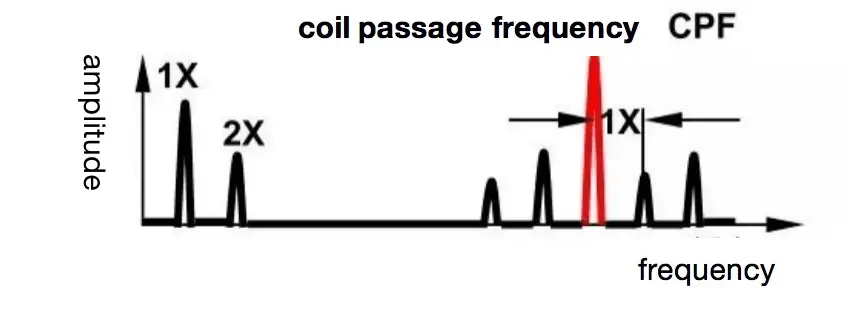
3 ) Power supply phase failure
Characteristics of power supply phase failure symptoms:
- Phase problems will cause the power supply frequency to double;
- (2FL) is accompanied by (1/3) FL side bands;
- The amplitude of electromagnetic vibrations at two power supply frequencies (2FL) can exceed peaks of 25 mm/s if power supply faults are not corrected;
- Local power connector failure is just an occasional contact failure.
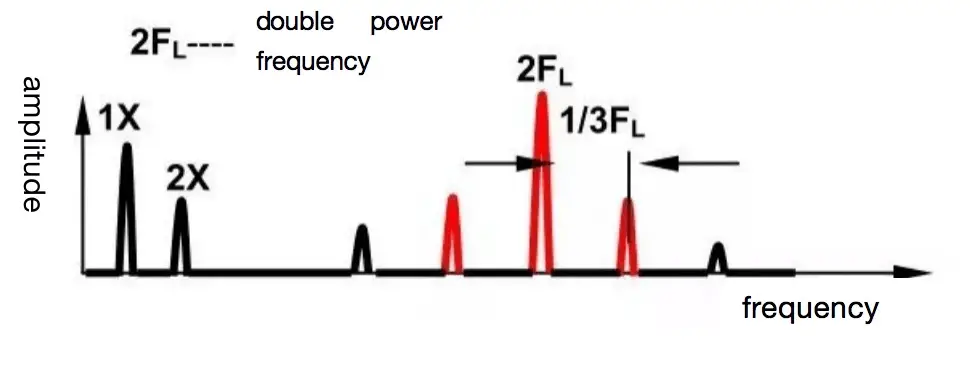
4 ) Eccentric rotors
Features of eccentric rotor symptoms:
- The eccentric rotor creates a rotating and variable air gap, which generates pulsed vibrations;
- Refinement spectroscopy is often required to separate the harmonic frequencies of the power supply dual frequency (2F) from the rotational speed.

5 ) B roken rotor bar
Characteristics of Broken Rotor Bar Symptoms:
- The rotational speed and its harmonic frequency accompanied by a sideband of pole passing frequency (Fp) on both sides indicates a rotor rupture failure;
- When the rotor bars pass on both sides of the frequency (RBPF), a double sideband of the power supply frequency (2FL) indicates that the rotor bar is loose.
- Often, the amplitude of the rotor bar passing frequency (RBPF) is very high at two (2XRBPF) and three times (3XRBPF), while the amplitude of the RBPF is very small at the fundamental frequency (1XRBPF).
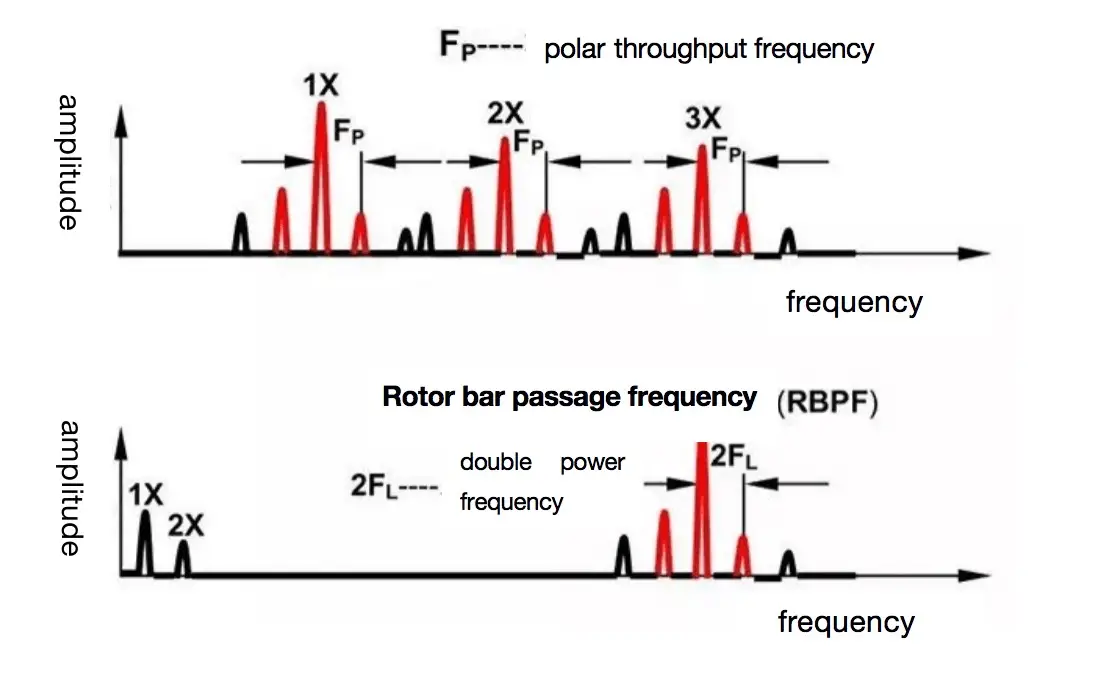
12 . DC Motors
Characteristics of DC motor failure symptoms:
- DC motor faults can be detected using a higher than normal thyristor frequency (SCR).
- These failures include broken winding coils and failures of fuses and control boards that can produce high-amplitude vibrations at 1X to 5X power frequencies.
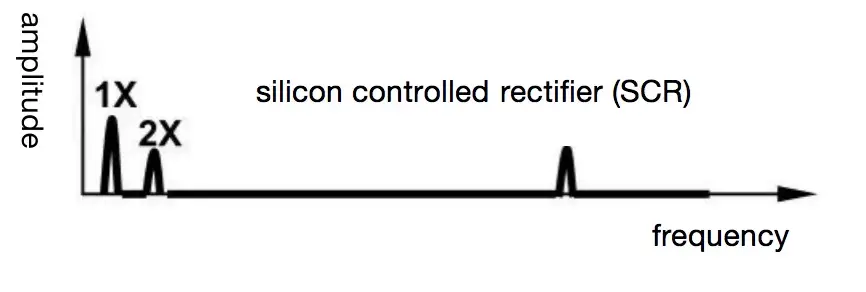
13 . Gear failure
Normal state spectrum:
- The normal state spectrum shows 1X and 2X speed frequency and GMF gear mesh frequency;
- The GMF gear mesh frequency is generally accompanied by a rotational speed frequency sideband;
- All vibration peaks have low amplitude, with no self-oscillation frequency.
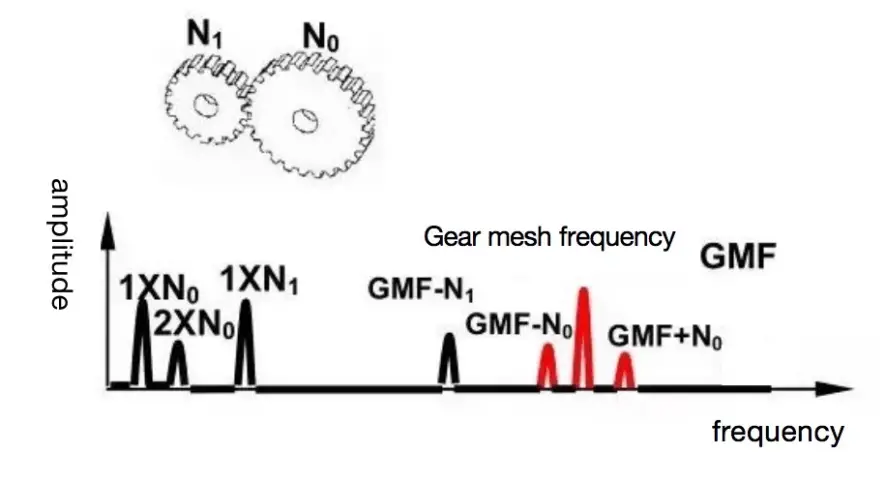
1 ) Effect of tooth loading
Characteristics of symptoms from the effects of tooth loading:
- Gear mesh frequency is often load sensitive;
- High amplitude GMF gear mesh frequency does not necessarily indicate gear failure;
- Each analysis must be carried out with maximum load.

two ) T tooth wear
Characteristics of tooth wear symptoms:
- Excitation of the self-oscillation frequency is accompanied by a sideband that wears the gear at 1X the rotational frequency, indicating tooth wear;
- Sidebands are a better indicator of wear than GMF gear mesh frequency;
- The frequency amplitude of the gear cannot change as the gear teeth wear.
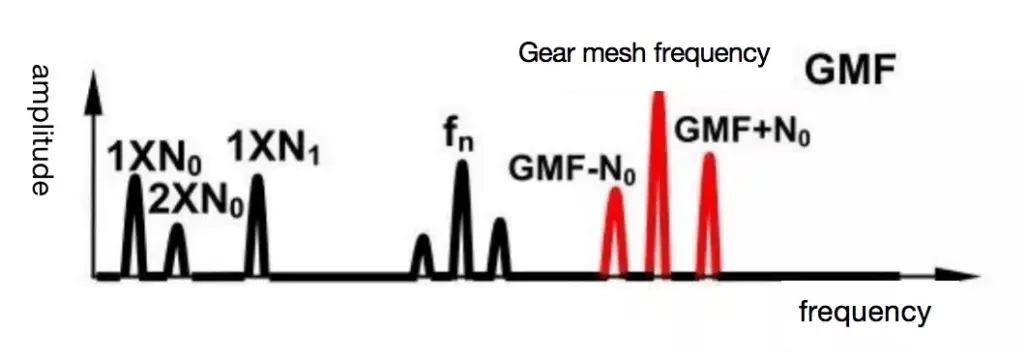
3 ) Gear runout and backlash displacement
Characteristics of gear runout and side play excursion symptoms:
- Larger amplitude sidebands on either side of the gear GMF frequency indicate that the excursion of the gear eccentric sideplay and the gear axis are not parallel;
- Defective gears will modulate the sidebands;
- Abnormal backlash excursions will normally cause the gear to vibrate at the self-oscillation frequency.
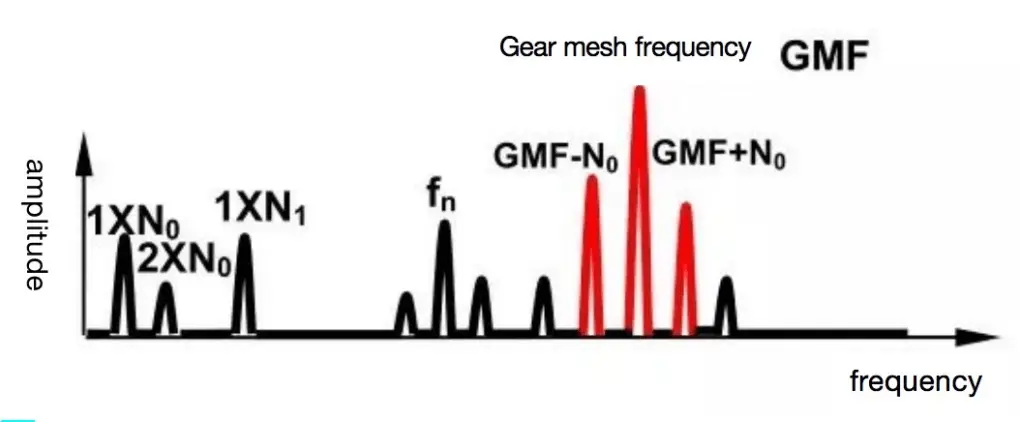
4 ) Gear misalignment
Symptomatic features of gear misalignment:
- Gear misalignment always excites harmonic frequencies of second-order or higher gear mesh frequencies, which are accompanied by a rotational speed frequency sideband;
- The magnitude of the base frequency of the gear mesh frequency (1XGMF) is smaller, while the magnitude of the 2X and 3X gear mesh frequencies is larger;
- To capture at least 2X GMF frequencies, it is important to set a sufficiently high value with the maximum analysis frequency Fmax.
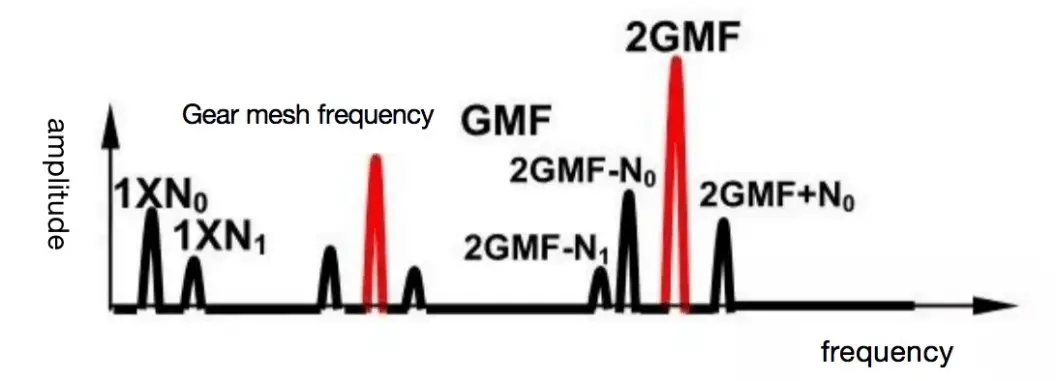
5 ) Broken/cracked teeth
Symptomatic features of broken/lost teeth:
- A broken or cracked tooth will produce a high amplitude vibration at 1X the speed frequency of that gear;
- It will induce a self-oscillating frequency vibration with a rotational speed fundamental sideband on both sides;
- It uses time domain waveform to better indicate a broken or cracked tooth gap;
- The time interval between the two pulses is the inverse of 1X the speed.
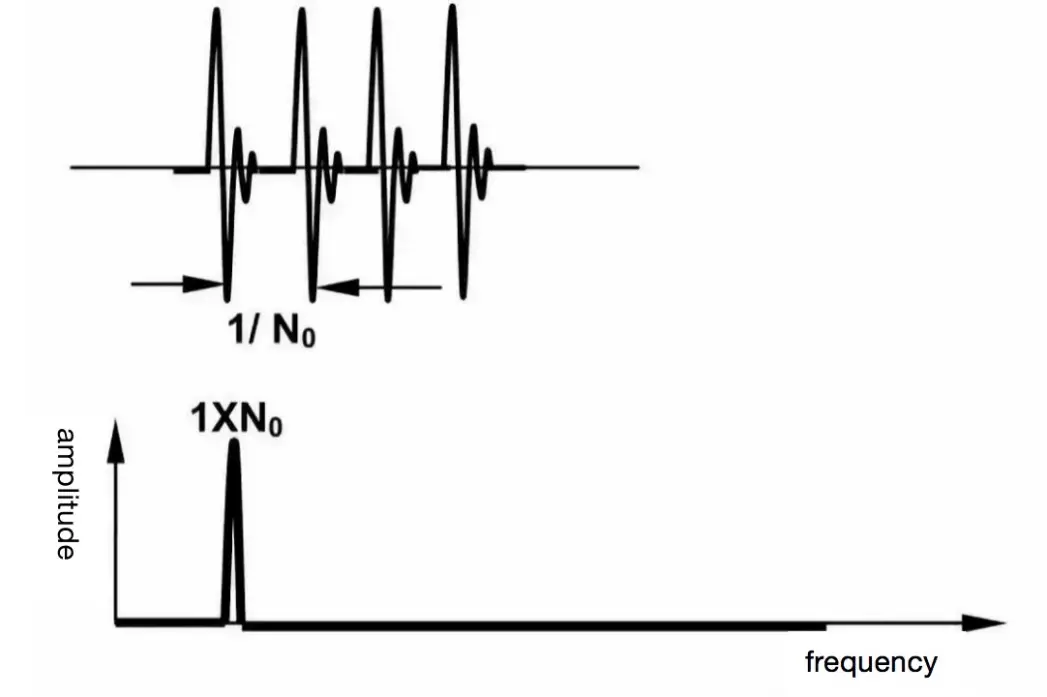
6 ) Teeth wear
Symptomatic features of wobbling teeth:
- The vibration of oscillating gears is a low-frequency vibration that is often ignored.

14 . Bearings
1 ) Phase 1 of the development of bearing failures
Characteristics of symptoms of the first stage of bearing failure development:
- From the first indications in the ultrasonic frequency range (>250 KHz), the spectrum can be best evaluated using the vibration acceleration envelope technique (vibration peak energy gSE).
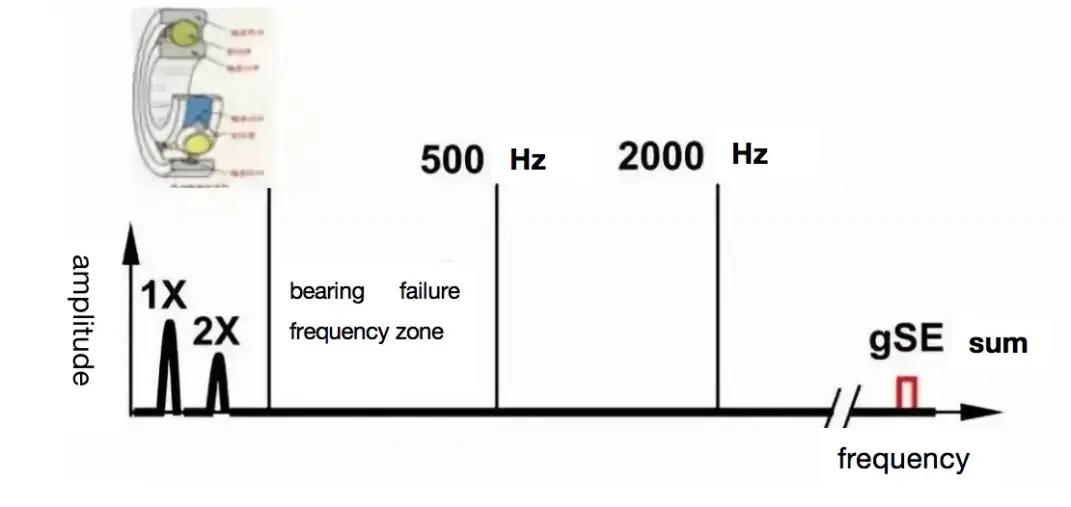
2 ) Phase 2 of the development of bearing failures
Symptomatic characteristics of the second stage of bearing failure development:
- Minor faults cause natural frequency vibration of bearing components.
- The failure frequency is in the range of 500-2000 Hz.
- At the end of the second stage of bearing failure development, sideband frequencies appear on the left and right sides of the self-oscillation frequency.
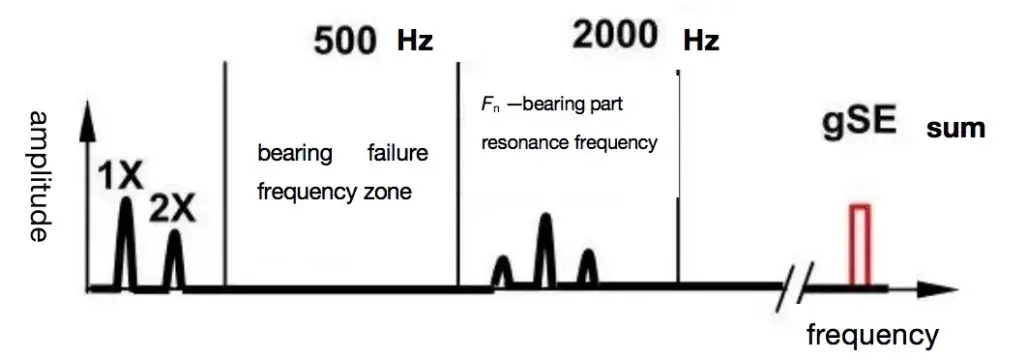
3 ) Phase 3 of the development of bearing failures
Characteristic symptoms of Phase 3 bearing failure development:
- It has bearing failure frequency and harmonic frequencies
- The number of sidebands increases with the number of harmonic frequencies at which the fault frequency occurs with heavy wear;
- At this stage, wear is visible to the naked eye and spreads around the circumference of the bearing.

4 ) Phase 4 of the development of bearing failures
Characteristics of phase 4 symptoms of bearing failure development:
- Discrete bearing failure frequencies disappear and are replaced by broadband random vibrations in the form of noise horizons;
- At the end of this phase, it even affects the amplitude of the 1X speed frequency;
- In fact, the magnitude of the high-frequency noise horizon and the total magnitude can be reduced.
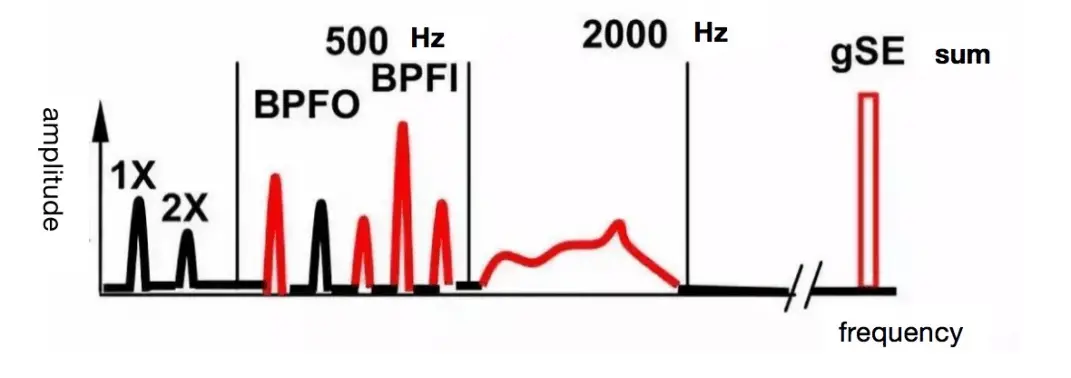
15 . Sliding Bearings
1 ) Oil film oscillation instability
Characteristics of oil film oscillation symptoms:
- Oil film oscillation may occur if the machine is operated at a critical rotor speed of 2X;
- When the rotor reaches the second critical rotor speed, the oil film forms vortices near the critical rotor speed, and excessive vibration will prevent the oil film from supporting the shaft;
- The oil film oscillation frequency is locked at the critical rotor speed; As the rotation speed increases, the oscillation frequency of the oil film does not increase.
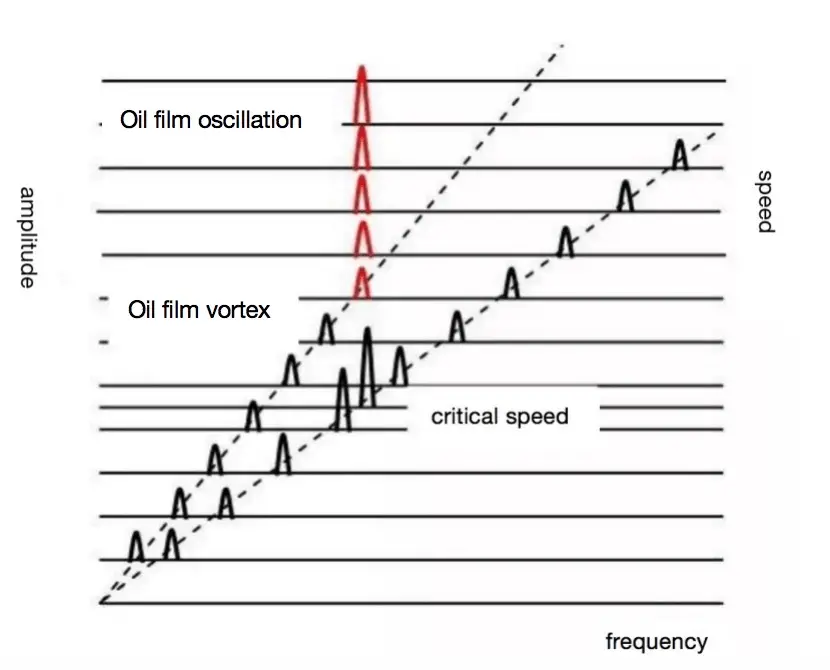
2 ) Instability
Features of oil film vortex symptoms:
- It generally occurs in the frequency range of 42-48% of rotational speed.
- Sometimes the vibration amplitude is very large and the vorticity of the oil film is inherently unstable because the centrifugal force increases and therefore the vorticity force increases.
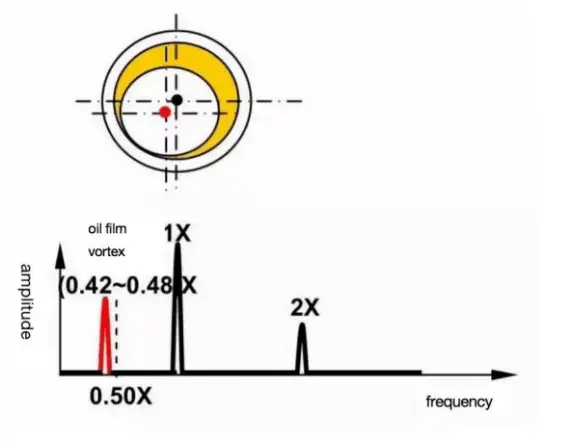
3 ) Wear/failure of sliding bearing clearance
Characteristics of sliding bearing clearance wear/failure symptoms:
- Large amplitude harmonic frequency vibrations at rotational speed frequencies are generated in the post-wear phase of the sliding bearing;
- When there is excessive sliding bearing play, small imbalances or misalignments can lead to large amounts of vibration.


























































